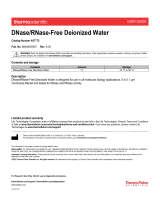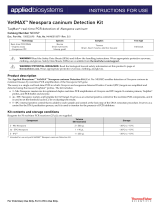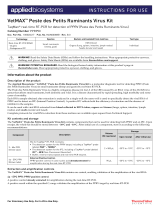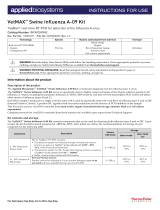Page is loading ...

For Veterinary Use Only. For In Vitro Use Only.
INSTRUCTIONS FOR USE
VetMAX™ C. burnetii Absolute Quant Kit
TaqMan® real-time PCR for detection and quantification of Coxiella burnetii, responsible for Q fever
Catalog Number FQPAQ
Doc. Part No. 100020367 Pub. No. MAN0008368 Rev. B.0
Technology
Specie(s)
Nucleic acid isolated from matrices
Test type
Real-time PCR (DNA)
–Duplex
–Endogenous IPC
Bovines
Small ruminants
(sheep, goat)
Swabs (cervical, vaginal and placental)
Milk
Vaginal mucus
Amniotic fluid
Organs (placenta or fetal tissue)
Individual
Pool of 3 samples
(depending on matrices)
WARNING! Read the Safety Data Sheets (SDSs) and follow the handling instructions. Wear appropriate protective eyewear,
clothing, and gloves. Safety Data Sheets (SDSs) are available from thermofisher.com/support.
WARNING! POTENTIAL BIOHAZARD. Read the biological hazard safety information at this product’s page at
thermofisher.com. Wear appropriate protective eyewear, clothing, and gloves.
Information about the product
Description of the product
Q fever (Query fever) is a zoonosis caused by Coxiella burnetii, an obligate intracellular bacteria that can infect many animal species as
well as humans. In ruminants, this disease is mainly associated with the appearance of reproductive problems. Coxiella burnetii causes
prematurity, low birth weights and miscarriages.
The Applied Biosystems™ VetMAX™ C. burnetii Absolute Quant Kit is a molecular diagnostic tool for Q fever. It enables specific
detection of the Coxiella burnetii bacteria by real-time PCR. It can be used in a qualitative application (presence or absence of bacteria) or
an absolute quantitative application (concentration of bacteria per sample unit).
Each DNA sample obtained after extraction is analyzed in a single well: the same well is used for specific detection of the bacterial
DNA of Coxiella burnetii and for the detection of an IPC (Internal Positive Control). A positive IPC reflects both the efficiency of
extraction and the absence of inhibitor in the samples.
It can be used with bacterial DNA extracted from swabs (cervical, vaginal and placental), milk, vaginal mucus, amniotic fluid or
organs (placental or fetal tissue). For swabs only, the analysis can be performed on pools of 3 samples.
Complete protocols for DNA extractions from these matrices are available upon request from Technical Support.
Kit contents and storage
The VetMAX™ C. burnetii Absolute Quant Kit comes in a case containing the different components. Upon receipt, the entire kit
should be stored at −30°C to −10°C. After thawing for the initial use, follow the recommendations for storage of each component in the
following table:
Component Description Volume
(100 tests)
Storage
Upon receipt
After initial
use
3 - Mix Cox b.
(Green tube)
Mix for TaqMan® PCR. Contains:
•The detection system for
Coxiella burnetii
target: forward and
reverse primers, as well as a TaqMan® probe labeled
FAM™ - TAMRA™.
•The detection system for IPC: forward and reverse primers,
as well as a TaqMan® probe labeled VIC™ - NFQ
(NFQ = Non-Fluorescent Quencher).
•The buffer and the PCR enzyme, as well as Uracil
N-Glycosylase.
2 × 1000 µL −30°C to −10°C +2°C to +8°C
4b - Standard PC. Cox b.
(Brown tube)(1)
The kit’s standard for
Coxiella burnetii
quantification. This is
plasmid DNA for dilution to prepare a quantification range. Its
use enables absolute quantification of an unknown sample.
100 µL −30°C to −10°C −30°C to −10°C
(1) The tube of 4b - Standard PC. Cox b. should be used with caution; the high DNA target concentration can be a source of contamination.
Extraction and amplification controls
The VetMAX™ C. burnetii Absolute Quant Kit contains 1 control, enabling validation of the amplification of the bacterial DNA and
quantification of the samples:

2 VetMAX™ C. burnetii Absolute Quant Kit Instructions for Use
4b - Standard PC. Cox b.: Coxiella burnetii positive control
Positive control, already extracted, to be amplified during real-time PCR. A positive result within the specified Ct range is used to
validate the amplification of the Coxiella burnetii target by real-time PCR.
This standard is quantified at 3.00 × 107 copies GE/mL. Dilution of the range standard, followed by amplification of this range during
real-time PCR, enables quantification of the samples.
Validation of nucleic acid extraction for each sample is done by detection of an endogenous IPC (Internal Positive Control), present
in every sample. A positive IPC result with a compliant value in a sample validates the extraction of this sample, whether positive or
negative for the target pathogen, thus eliminating false negatives and verifying the inhibitor effect.
We recommend that two negative controls be performed to confirm correct analysis:
NCS: negative extraction control
This control consists of reagents used in the extraction without addition of the sample (it can be replaced by the buffer used in the
sample preparation or by DNase/RNase-free water), which undergoes the same treatment as the samples: nucleic acid extraction and
then real-time PCR.
A negative result for Coxiella burnetii and for the IPC confirms the absence of contamination during the extraction and the real-time PCR.
NC: negative amplification control
This control consists of 20 µL of the real-time PCR mix and 5 µL of DNase/RNase-free water undergoing real-time PCR.
A negative result for all targets (Coxiella burnetii and IPC) confirms the absence of contamination during PCR reaction preparation.
Materials required but not provided
Unless otherwise indicated, all materials are available through thermofisher.com.
• Precision micropipettes (range of 1 µL to 1000 µL) with DNase/RNase-free filtered tips
• DNase/RNase-free water
• 1X TE buffer
• 1X PBS buffer
• A real-time PCR thermal cycler capable of detecting the following fluorophores:
– FAM™ (maximum emission: λ515 nm)
– VIC™ (maximum emission: λ554 nm)
• Optical-quality consumables compatible with the thermal cycler used:
– PCR plates with 96 wells, PCR strips (8 or 12 wells), microtubes or capillaries
– Films or caps suitable for closing
Analysis procedure
The real-time PCR reaction volume is 25 µL:
• 3 - Mix Cox b.: 20 µL per analysis.
• Extracted DNA: 5 µL per analysis.
For a quantitative application: prepare the quantification range using 4b - Standard PC. Cox b.
DNA extraction
It is necessary to isolate the DNA from the samples for real-time PCR analysis. To facilitate the quantification of non-liquid samples, it
is recommended to work with a swab eluate or with supernatant from crushed organ made in 1 mL of PBS 1X.
NOTE: For information about extraction methods that are compatible with the VetMAX™ C. burnetii Absolute Quant Kit, please contact
Technical Support.
Preparation of the quantification range
Take appropriate precautionary measures to avoid contamination of the real-time PCR mix 3 - Mix Cox b when performing this step.
Serially dilute the DNA from 4b - Standard PC. Cox b. to 1:10, preferably in 1X TE buffer for better storage (or in DNase/RNase-free
water) to constitute the 5 range points:
Range point
Concentration
Preparation of range point
Point 1 (Standard PC. Cox b.10
−1
)
3.00 × 10
6
copies GE
(2)
/mL
20 µL of 4b - Standard PC. Cox b. + 180 µL of 1X TE
Point 2 (Standard PC. Cox b.10
−2
) = EPC Cox b.
(1)
3.00 × 10
5
copies GE/mL
20 µL of Standard PC. Cox b. 10
−1
+ 180 µL of 1X TE
Point 3 (Standard PC. Cox b.10
−3
)
3.00 × 10
4
copies GE/mL
20 µL of Standard PC. Cox b. 10
−2
+ 180 µL of 1X TE
Point 4 (Standard PC. Cox b.10
−4
)
3.00 × 10
3
copies GE/mL
20 µL of Standard PC. Cox b. 10
−3
+ 180 µL of 1X TE
Point 5 (Standard PC. Cox b.10−5) 3.00 × 102 copies GE/mL 20 µL of Standard PC. Cox b. 10−4 + 180 µL of 1X TE
Serial dilution factor: 1:10
(1) For qualitative application, it is not necessary to add the entire range of quantification. A single dilution point for this range is used as the amplification control:
EPC Cox b.
(= DNA standard Cox b. 3.00 × 105).
(2) Genome Equivalent.
Aliquot the DNA standards below 30 µL and store them below −16°C for the entire period of kit storage. More than 3 cycles of
freezing/thawing standard DNA is not recommended.

VetMAX™ C. burnetii Absolute Quant Kit Instructions for Use 3
Preparation of the real-time PCR
1. Create an analysis plan for distribution of the mixes and samples. Keep the quantification range or the EPC away from the other
samples, if possible.
2. Thoroughly mix the 3 - Mix Cox b. tube by gentle agitation, then centrifuge briefly.
3. Add 20 µL of 3 - Mix Cox b. to each well of the PCR plate, PCR strip or capillary used.
4. Add the DNA samples and controls to each reaction mix according to the predefined analysis plan:
Type of analysis
Component
Sample volume
Sample for analysis
DNA extracted from the sample
5 µL
Quantification range
Dilution range of 4b - Standard PC. Cox b.
5 µL
Positive amplification control
(1)
EPC Cox b. (= standard PC. Cox b. 10
−2
)
5 µL
Negative extraction control (NCS)
Extracted NCS
5 µL
Negative amplification control (NC)
DNase/RNase-free water
5 µL
(1) This point replaces the range of quantification for qualitative applications.
5. Cover the PCR plate, PCR strips or capillaries with an adhesive film or suitable caps.
Amplification by real-time PCR
1. Create the following detectors on the thermal cycler:
Reporter
Quencher
COXB (Coxiella burnetii)
FAM
™
TAMRA
™(1)
IPC COXB
VIC
™
NFQ (Non-Fluorescent Quencher)
Passive reference: ROX
™(1)
(1) The fluorophores TAMRA™ and ROX™ must be entered for real-time PCR analysis if the thermal cycler is capable of detecting them. For other thermal
cyclers, absence of detection of these fluorophores does not compromise the analysis by real-time PCR.
2. Assign the COXB detector and the IPC COXB detector to each sample well used in the analysis.
3. Assign the quantification values (copies/mL) for each quantification range point.
4. Set up the following real-time PCR program for the analysis:
Step repetitions
Temperature
Duration
Step 1
1×
50°C
2 minutes (02’00”)
Step 2
1×
95°C
10 minutes (10’00”)
Step 3 45×
95°C
15 seconds (00’15”)
60°C
(1)
1 minute (01’00")
(1) Collection of fluorescence data during the 60°C – 1 minute phase
5. Place the PCR plate, the PCR strips or the capillaries in the thermal cycler and run the real-time PCR.
Analysis of the results
Analysis of the raw data
Refer to the recommendations of the thermal cycler manufacturer for analysis of the raw data.
1. Set the threshold limits separately for each real-time PCR target.
2. Interpret the results based on the Ct values of the samples for each detector according to the following recommendations.
Test validation
Validation of qualitative tests
The qualitative test is validated if the following acceptance criteria are met:
COXB detector
IPC COXB detector
Validation
EPC Cox b.
C
t
= C
t
QC
COXB of Standard PC. Cox b.10
−2
±3C
t(1)
C
t
< 45 or C
t
> 45
(2)
PCR validated
NCS
C
t
> 45
C
t
> 45
Extraction step validated (no contamination)
NC
Ct > 45 Ct > 45 PCR components validated (no contamination)
(1) Refer to the values listed in section 2.1 “EPC” of the Certificate of Analysis for the lot used for the test.
(2) The IPC value in the EPC should not be used to validate the test.
Additional validation criteria for quantitative tests
If not already performed, assign quantification values (copies/mL) to each quantification range point in the thermal cycler’s real-time PCR
software. The quantitative test is validated using the following acceptance criteria, as well as the qualitative test validation criteria.
COXB detector
PCR efficacy
Correlation coefficient R
2
Interpretation
Standard
quantification
range
At least 4 out of 5 of the range points validated
according to the conditions:
Ct = Ct QC COXB of Standard PC. Cox b. ±3Ct(1)
Between 85% and 115% R2 > 0.980 Quantification range
validated
(1) Refer to the values for the different points of the range listed in section 2.1 “EPC” of the Certificate of Analysis of the lot used for the test. An abnormal point
can be eliminated from within the range, but not from the limits.

thermofisher.com/support | thermofisher.com/askaquestion
thermofisher.com
31 May 2017
Interpretation of the results
Qualitative application
For each sample analyzed, the results should be interpreted as shown below:
COXB detector
IPC COXB detector
Interpretation
C
t
< 45
C
t
< 45 or C
t
> 45
Coxiella burnetii
detected
C
t
> 45
C
t
< 45
Coxiella burnetii
not detected
C
t
> 45
C
t
> 45
Not validated
Quantitative application
Calculating the concentration in the DNA sample
For the absolute quantification of a DNA sample in which the Coxiella burnetii target has been detected:
1. Make sure that the quantification range is validated.
2. Use the real-time PCR software to calculate the Coxiella burnetii target quantity for each sample using the quantification range values.
Calculating the concentration in the liquid sample before purification of nucleic acid
The calculation is performed from the quantification of the DNA sample obtained during PCR (in copies/mL), the volume of the test
sample for extraction (TS) expressed in µL and the elution volume (EV) of the extraction method expressed in µL:
Liquid sample quantification (copies C. burnetii / mL) = PCR quantification (copies/mL) × [EV (µL) / TS (µL)]
Calculating the quantification of organs from the quantification of crushed organ supernatant
Quantification per mg of organ based on the quantification of the crushed organ supernatant (copies/mL), the volume of buffer used
for crushing (CV) in mL and the quantity of sample (QS) in mg:
Organ quantification (copies C. burnetii / mg) = crushed organ supernatant quantification (copies/mL) × [CV (mL) / QS (mg)]
Procedure for handling non-validated samples
For the analyses described below, it is important to take into consideration the dilution factors applied over the course of the process
during sample quantification calculation.
1. Dilute the DNA of the non-validated sample as indicated: at a 1:10 dilution in 1X TE buffer.
2. Perform a new real-time PCR analysis with 5 µL of this dilution.
3. If the diluted DNA is positive for Coxiella burnetii or negative for Coxiella burnetii with a compliant IPC result, then the obtained
result is validated.
4. If the diluted DNA is negative for Coxiella burnetii with a non-compliant IPC result, the obtained result is not yet validated. In this
case, repeat the nucleic acid extraction using the sample pre-diluted to 1:10 in 1X PBS buffer before extraction.
5. If the result is still not validated, repeat the analysis on a new sample.
Documentation and support
Customer and technical support
Technical support: visit thermofisher.com/askaquestion
Visit thermofisher.com/support for the latest in services and
support, including:
• Worldwide contact telephone numbers
• Order and web support
• User guides, manuals, and protocols
• Certificates of Analysis
• Safety Data Sheets (SDSs; also known as MSDSs)
NOTE: For SDSs for reagents and chemicals from other
manufacturers, contact the manufacturer.
Limited product warranty
Life Technologies Corporation and/or its affiliate(s) warrant
their products as set forth in the Life Technologies' General
Terms and Conditions of Sale found on Life Technologies'
website at www.thermofisher.com/us/en/home/global/
terms-and-conditions.html. If you have any questions, please
contact Life Technologies at thermofisher.com/support.
Laboratoire Service International (LSI) | 6 Allée des Écureuils |
Parc Tertiaire du Bois-Dieu | 69380 Lissieu, France
Translated from the French Pub. No. MAN0007807 Rev. B.0.
The information in this guide is subject to change without notice.
DISCLAIMER: TO THE EXTENT ALLOWED BY LAW, LIFE TECHNOLOGIES AND/OR
ITS AFFILIATE(S) WILL NOT BE LIABLE FOR SPECIAL, INCIDENTAL, INDIRECT,
PUNITIVE, MULTIPLE, OR CONSEQUENTIAL DAMAGES IN CONNECTION WITH
OR ARISING FROM THIS DOCUMENT, INCLUDING YOUR USE OF IT.
Revision history of Pub. No. MAN0008368 (English)
Revision
Date
Description
B.0 31 May 2017
Changed IPC. Modified standard concentration
unit. Updated to the current document template,
with associated updates to the warranty,
trademarks, and logos.
A.0
30 January 2014
Baseline for revision history
Limited Use Label License No. 460: PCR Veterinary Diagnostics. Notice to
Purchaser: For veterinary diagnostic services including the reporting of such
services for a fee and for research purposes only. Human diagnostic uses
require a separate license from Roche.
©2017 Thermo Fisher Scientific Inc. All rights reserved. All trademarks are the
property of Thermo Fisher Scientific and its subsidiaries unless otherwise
specified. TaqMan is a registered trademark of Roche, used under permission
and license.
/










